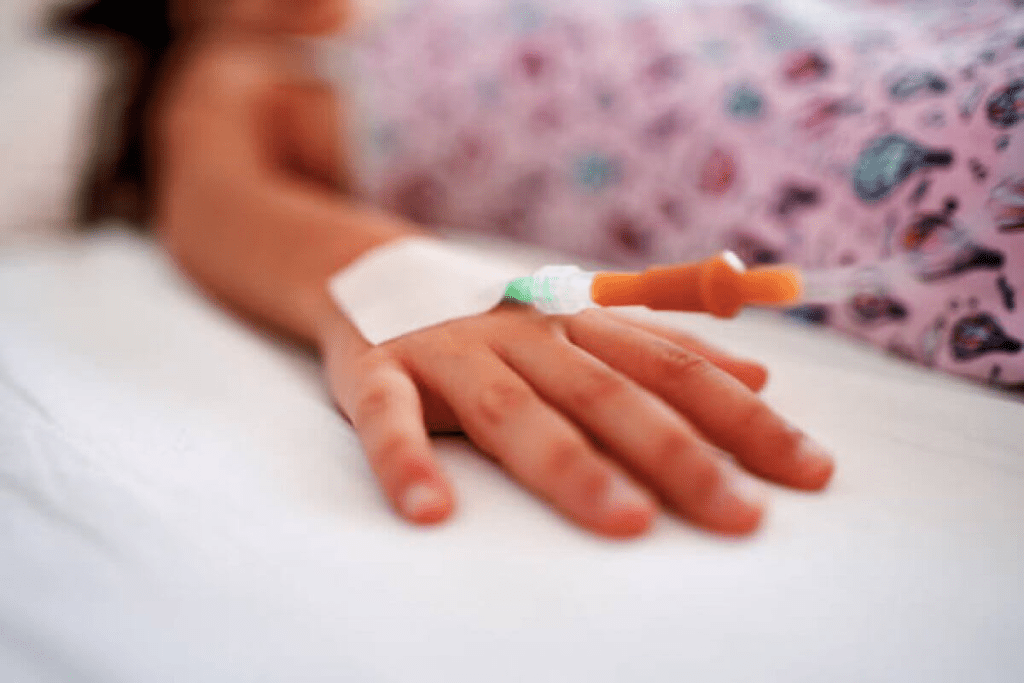Last Updated on November 13, 2025 by
Parents often find out their child has leukemia when they notice persistent symptoms. Leukemia is a cancer that affects the white blood cells. It makes it hard for the body to fight off infections.

Common signs include unexplained bruising, fatigue, and frequent infections. Bone pain and prolonged fever are also symptoms. We will look into these signs and how they lead to a diagnosis. Parents share their journey of diagnosis. Read their stories detailing the early signs and the moment they realized how i knew my child has leukemia.
According to global statistics, childhood leukemia is the most common cancer in kids. In 2021, there were about 58,785 new cases reported.
Early detection is key to effective treatment. By knowing the signs and symptoms, parents can get their child medical help quickly. This can greatly improve their child’s chances of recovery.
Leukemia in children often starts with subtle signs. These signs, when recognized early, can lead to timely medical intervention. As parents, being vigilant about these signs is key to ensuring your child gets the care they need quickly.

Children with leukemia may show a range of physical symptoms. One common sign is unexplained bruising or bleeding, caused by low platelet counts. They might also feel persistent fatigue and weakness, making it hard to do their usual activities.
Frequent infections are another sign, as leukemia weakens the immune system. Leukemia symptoms can include pale skin due to anemia, a low red blood cell count.
Certain behavioural changes can signal illness too. Children with leukemia might become more irritable or lethargic. They may lose interest in activities they once loved, showing fatigue and discomfort.
If you’re worried about your child’s health and wondering about the first signs my child has cancer, see a healthcare professional. Early detection is key to effective treatment.
Knowing these signs and acting quickly can greatly help your child’s recovery. If you’re concerned about your child’s health and think, “I’m worried my child has leukemia,” get medical advice without delay.
Parents need to understand childhood leukemia when their child is diagnosed. Leukemia is the most common cancer in kids. Knowing what it is and how it affects young patients is key.
Leukemia is a cancer that affects the blood and bone marrow. It causes an abnormal increase in white blood cells. In kids, it disrupts blood cell production, leading to health problems.
Key effects of leukemia on children include:
There are several types of leukemia in children. The most common are Acute Lymphoblastic Leukemia (ALL) and Acute Myeloid Leukemia (AML). ALL is the most common, affecting lymphocytes, which are important for the immune system.
AML affects myeloid cells, which produce different blood cells. Knowing the type of leukemia is important for choosing the right treatment.
The main types of childhood leukemia are:
Knowing the common symptoms of leukemia can help parents spot the signs early. When kids get leukemia, it’s often because parents notice a mix of symptoms. This leads them to see a doctor.
Unexplained bruising or bleeding is a scary sign that might mean leukemia. Kids with leukemia might get nosebleeds, bleeding gums, or bruises for any reason. This happens because leukemia messes with platelet production, which is key for blood to clot.
Persistent fatigue and weakness are common in kids with leukemia. The disease can lower red blood cell counts, leading to anemia. This makes kids feel very tired and weak.
Leukemia makes kids more likely to get sick because their immune systems are weak. Recurrent infections and prolonged fevers can be signs of leukemia. This is because the disease makes it hard for the body to fight off infections.
Leukemia can also cause bone and joint pain. This pain can be so bad it makes it hard for kids to move or walk properly. It happens because leukemia cells build up in bones and joints.
Spotting these symptoms early is key to catching leukemia. If your child shows any of these signs, it’s important to talk to a doctor right away.
Learning your child has leukemia is a journey filled with small signs and surprises. Parents who’ve been through it share their stories. They talk about the early signs and how important it is to trust your instincts.

Parents remember the first signs of leukemia in their kids were small and easy to miss. A child might have unexplained bruising or fatigue that doesn’t get better with rest. For example, a mother thought her daughter was just stressed from school, but it was leukemia.
These stories show how important it is to watch your child’s health closely. Sarah, a mom, noticed her son bruising easily and had fevers. She listened to her gut and got him checked, leading to a leukemia diagnosis.
It’s key to trust your instincts if you think something’s off with your child’s health. Parents often feel something’s wrong before they get a diagnosis. It’s vital to listen to your intuition and not ignore your worries, even if doctors don’t at first.
“I knew something was wrong with my child, but it took several visits to different doctors to get a diagnosis of leukemia. Trusting my instincts was key,” shared a mother whose child was diagnosed with leukemia.
Leukemia symptoms are often mistaken for other things, like the flu or a viral infection. A father said his son’s leukemia was first thought to be mononucleosis because of fever and fatigue. It took more doctor visits and tests to find the real diagnosis.
These stories show the value of persistent advocacy for your child’s health. If you’re not happy with the first diagnosis or treatment, getting a second opinion is important.
Diagnosing leukemia in children involves several key steps. These include doctor visits and detailed tests. Knowing these steps can help parents prepare for what’s ahead.
The journey starts with a visit to the pediatrician. They check the child’s symptoms and medical history. If they think it might be leukemia, they’ll send the child to a specialist for more checks.
Seeing a hematologist or oncologist is a big step. These experts can do and understand the needed tests. It’s important to know this referral is just a precaution, not a confirmation.
Diagnosing leukemia requires several tests, including:
These tests are key to finding out if leukemia is present and what type it is.
Blood work is often the first test for leukemia. If the results show abnormal cells, it could mean leukemia. Understanding these results and their role in diagnosis can be tough, but it’s vital. The hematologist will explain the findings and what they mean to the parents.
Getting a leukemia diagnosis is tough, but knowing the diagnostic steps can offer some comfort. By understanding the process, from the first doctor visits to test results, parents can better handle this hard time.
The rate of childhood leukemia changes a lot around the world. This is due to many things like where people live and who they are. Knowing these numbers is key for doctors, scientists, and families dealing with this illness.
Leukemia is the top cancer in kids, making up 30% of all cancers in children. The rates change with age, peaking between 2 and 5 years old. Acute lymphoblastic leukemia (ALL) is the biggest type, making up 80% of leukemia in kids.
Leukemia doesn’t affect all ages the same way. ALL hits kids early, while acute myeloid leukemia (AML) is more common in younger kids and teens.
Studies show boys get leukemia more often than girls. Boys are 1.2 times more likely to get ALL than girls. The exact reasons are not known, but genetics and hormones might play a part.
Leukemia rates and how it’s treated vary by place. Rates are often higher in rich countries than in poor ones. But better treatments have raised survival chances worldwide, with some places seeing over 90% survival rates for certain leukemias.
It’s vital to understand these global leukemia stats. This helps in making better plans to help kids with leukemia everywhere.
When a child is diagnosed with leukemia, families face an unexpected emotional journey. This path is filled with shock, denial, fear, and hope. It’s a complex mix of feelings.
The first reaction to a leukemia diagnosis can be too much. Parents often feel numb or can’t believe it’s happening. It’s important to:
Children with leukemia pick up on their parents’ worries. It’s key to:
Supporting your child means being there for them, giving emotional comfort, and fighting for their needs during treatment.
A leukemia diagnosis impacts the whole family. Finding support is vital for:
Support can come from healthcare professionals, support groups, and online resources.
Talking openly with siblings and extended family about the diagnosis is important. This includes:
Good communication helps build a supportive network around your child and family.
Childhood leukemia treatment has changed a lot. Now, there are many options for each patient. Going through diagnosis and treatment can be tough. But knowing the treatment options helps parents make better choices.
Most leukemia treatments start with chemotherapy. Chemotherapy kills leukemia cells. Sometimes, radiation therapy is used too. It targets areas with leukemia cells.
Another option is a stem cell transplant. This replaces bad bone marrow with healthy cells. These cells can come from the patient or a donor.
New treatments and clinical trials offer hope. They include targeted therapies and immunotherapies. These treatments aim to kill leukemia cells without harming normal cells.
Joining a clinical trial can give access to new treatments. We talk to the medical team about the benefits and risks. They help decide if a trial is right for the child.
Children with leukemia get care from a multidisciplinary team. This team includes doctors, nurses, and more. They work together to create a treatment plan for each child.
Specialized treatment centers are key to leukemia care. They have experienced teams and the latest facilities. These centers also do research and offer clinical trials.
Choosing a treatment center is important. We look at their experience, trial options, and support services.
Being an advocate for your child during leukemia treatment means working closely with their medical team. This partnership is key to getting your child the best care. As a parent, you play a huge role in helping your child through treatment.
A strong partnership with the medical team is built on open communication, trust, and respect. It’s important to feel comfortable asking questions and sharing concerns about your child’s treatment. Regular updates and clear explanations from the medical team can help reduce anxiety and help you make informed decisions.
To build this partnership, consider the following steps:
Asking the right questions is key to advocating for your child. It helps you understand their treatment plan, possible side effects, and follow-up care. Don’t hesitate to seek clarification on any aspect of your child’s treatment.
Some essential questions to ask include:
Sometimes, getting a second opinion can offer new insights or confirm the initial diagnosis and treatment plan. It’s your right as a parent to seek another medical opinion, and it can be a valuable step in ensuring your child receives the most appropriate care.
When considering a second opinion, you might ask:
Managing your child’s school and social life during treatment is important for their emotional and psychological well-being. It’s essential to maintain as much normalcy as possible, adapting to the needs and limitations imposed by the treatment.
Strategies for managing school and social life include:
Medical treatments have greatly improved, giving hope to families with childhood leukemia. Knowing what affects prognosis and how survival rates have grown is key. It helps families feel more secure and hopeful.
The outlook for kids with leukemia depends on several things. These include the leukemia type, the child’s age, and how well the leukemia responds to treatment. Starting treatment early is very important for better survival chances. Genetic factors and biomarkers also play a role in treatment success.
In recent years, survival rates for kids with leukemia have greatly improved. Better chemotherapy, targeted therapy, and care have led to this progress. Many children now live long, healthy lives after treatment.
After leukemia treatment, ongoing care is vital. Regular check-ups help catch any late treatment effects early. This includes managing side effects and watching for secondary cancers.
Leukemia treatment can lead to late effects. These can affect growth, fertility, and increase cancer risk. It’s important to catch and manage these effects early for the best quality. We work with teams to provide full care and support.
Understanding survival rates and the long-term outlook helps families face leukemia challenges. It brings hope and support from medical progress.
Getting a leukemia diagnosis can change a family’s life. But thanks to modern treatments, there’s hope for a good outcome. We’ve talked about spotting early signs, getting to the diagnosis, and looking at treatment options.
After a diagnosis, families need to be strong, get support, and find quality care. They can find comfort in knowing they’re not alone. Many resources and support systems are ready to help them through this tough time.
It’s important to keep moving forward, knowing treatments have gotten better. Understanding the prognosis and long-term care helps families cope better. We urge families to stay active, seek help, and stay hopeful after a leukemia diagnosis.
Look out for signs like unexplained bruises, feeling very tired, and getting sick often. If you see these, talk to your child’s doctor right away.
Doctors use blood tests, bone marrow biopsies, and imaging to find out if your child has leukemia. They will explain everything to you.
There are two main types: Acute Lymphoblastic Leukemia (ALL) and Acute Myeloid Leukemia (AML). Knowing the type helps doctors choose the best treatment.
Be there for them emotionally, help them stick to their treatment plan, and deal with any side effects. Also, keep talking to their doctors and get help for your whole family.
Treatment might include chemotherapy, special medicines, and sometimes a bone marrow transplant. The plan depends on the leukemia type, stage, and your child’s health.
Work closely with the doctors, ask questions, and get a second opinion if needed. Also, help manage their school and social life to keep them happy and healthy.
Thanks to advances, many kids can beat leukemia. The outlook depends on the leukemia type, how well it responds to treatment, and your child’s overall health. Your child’s doctors will talk about their chances.
Treatment can lead to issues like growth problems, more infections, and even other cancers later. Regular check-ups and care are key to managing these effects and keeping your child healthy.
It’s okay to feel shocked and worried. Support your child, talk openly with their doctors, and find help for your family. Friends, family, and support groups can also offer a lot of help.
Know the signs, how it’s diagnosed, treatment options, and how to support your child. Being informed and working with the medical team is very important.
Kids might show signs like bruises, tiredness, and getting sick a lot. If you’re worried, it’s important to talk to your child’s doctor.
Expect visits to the doctor, referrals to specialists, and tests. Knowing what’s coming can help you prepare for the journey ahead.
Work with the doctors and the school to keep your child’s life as normal as possible. Many places have help for kids to keep up with school and friends during treatment.
Childhood leukemia is the most common cancer in kids, with about 58,785 new cases in 2021. Knowing these numbers can give you insight into how common it is and where it’s more common.
Make sure she gets care from a team of experts, manages any side effects, and talks a lot with her doctors. Also, support her emotionally and help her follow her treatment plan.
Trusting your instincts is very important. If you’re worried about your child’s health, don’t hesitate to get medical help. Your instincts can help spot health problems early.
Sometimes, leukemia is mistaken for viral infections or anemia. If symptoms don’t go away or get worse, it’s important to get a proper diagnosis.
Support from family, friends, and groups can be a big help. Many places also offer counselling and resources for families going through treatment.
Subscribe to our e-newsletter to stay informed about the latest innovations in the world of health and exclusive offers!